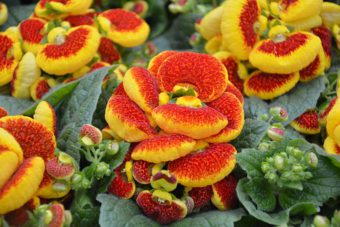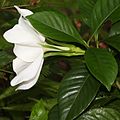In this article, I will be talking about what colour schemes to use with houseplants. In past articles, I have discussed how the colour schemes are generated in the first place, along with the outside plants that meet the cool, hot and dark, and pastel colour schemes. This decision of what colour scheme to use can be extended to indoor gardening. Most houseplants will follow the same scheme as mentioned in this article.

The great thing about colour schemes for houseplants is that it is not much of a problem, as adherence to strict colour rules does not inhibit experimentation. If a plant clashes with the background, you have two options available to you; you can either move the plant or you can change the background by changing the paint colour or wallpaper.
It is best to have tried a plant in a certain position and to know it does not belong than to wonder if it just might.
CREATE CONTRASTS
The colour contrast of plants and pale or light coloured backgrounds create a feeling of spacious. Rooms with plants sitting in all white or magnolia background create a feeling of clinical elegance, whereas light-coloured plants against a dark background create a sense of closeness and snugness.
Soft pastel-coloured flowering plants against a delicately patterned wallpaper immediately bring an overall feeling of comfort and ease. High contrast between coloured flowers and the background are best retained for dining area and halls, whilst soft colours are best suited for living rooms and bedrooms.
If you have a teenage child they may go for more bizarre combinations and they must not be discouraged from doing so, but very young children’s bedrooms must not be as bold, but use plants and colour scheme that are soothing in nature.
You can also use colourful containers that will blend or contrast with your home décor, whilst highlighting the plant that is within it. You can play around with paints, wallpaper, containers and plants within them until a design that you are happy with, is reached.
COLOURS OF FLOWERS TO USE
ORANGE AND YELLOW FLOWERS

If you are looking for orange and yellow flowers, you can use back-eyed Susan (Thunbergia alata), which is a summer delight with its chocolate brown centres and orange-yellow petals. Chrysanthemums, crocuses, daffodils, primulas, all have yellow, or orange flowers that can be used in this scheme.
Kalanchoes also has flowers that come in orange and yellow, and so do hyacinths. Calceolaria x herbeohybrida has yellow flowers that are often speckled and dabbled in a range of other colours You cannot go awry if you use a Clivia in this colour scheme.
RED AND PINK FLOWERS

There are a number of plants that produce red flowers from cyclamen and impatiens, along with Gloxinia and Senecio varieties, along with Kalanchoes that has red and pink varieties. Hyacinths and amaryllis come in shades of red as well. So you do have a wide choice.
BLUE FLOWERS

Hyacinths, Campanula isophylla and Ipomoea rubro-caerulea are well-known varieties that have blue flowers. You can also grow a blue form of hydrangea to cover this shade as well, as long as an acidic compost is used.
PURPLE FLOWERS
There are a number of houseplants that produces flowers of the purple shade. This includes Cape Primrose (Streptocarpus), which is a summer delight, where ‘Constant Nymph’ being the preferred option because of its darker vein in the flower throats.

Saint Paulias is the star and comes in a wide range of colours if you can look after them right.
Crocus, Senecios, Brunfelsia calycina and Browallia speciosa also produce purple flowers.
WHITE FLOWERS
There a large number of species that produce white coloured blooms, including white varieties of Campanula isophyllas, Cyclamens, Hyacinths, Daffodils, Amaryllis and Chrysanthemums.

Madagascar Jasmine (Stephanotis floribunda) and Jasminum polyanthum are both scented climbing plants that will grace a lot of homes. Both need a lot of space to grow, as they are best grown in a conservatory, where they can be allowed to grow to its full potential.
Gardenias are another scented plant that can be grown inside, provided that high temperatures and a warm conservatory are used. You have so many options with this colour scheme.
COLOURFUL FOLIAGE
ORANGE AND YELLOW FOLIAGE

Dieffenbachia picta ‘Exotica’ has leaves that are suffused with pale yellow. You can also use the colourful Coleus that often have some orange and yellow in their foliage, along with the many varieties of Codiaeum variegatum pictum. A lot of Bromeliads have bracts that have yellow or orange associated with them.
RED AND PINK FOLIAGE

Coleus as ever is the go-to plant as it has varieties with some red in their leaves. The Cabbage Palm (Cordyline fruticosa) ‘Firebrand’ and ‘Guilfoylei’ have leaves with pink or red. Bromeliads also have colourful bracts that came in these shades, as well as many forms of Caladium have leaves with this shade in them.
BLUE FOLIAGE
Eucalyptus gunnii, Aechmea fasciata and many forms of Sedum have blue-greenish leaves.
PURPLE OR DARK LEAVES
The most distinctive of the dark foliage plant is Setcreasea purpurea, with long purple leaves and a neat habit.

The climber/trailing Gynura aurantiaca has leaves that have bright purple hairs but its only downfall is the yellow flowers that are produced tend to have an unpleasant scent. The flowers that are produced in February can be cut off as soon as they develop, saving your nose from being exposed to the scent.
Some Coleus also come in purple varieties and are worth looking for. Iresine herbsii develops shiny, heart-shaped purple leaves, where it is best grown in a good light.
More colourful leaved plants can be found in my article about them here, whilst more colourful flowering plants can be found here.
CONCLUSIONS
In this article, we have discussed how you can provide a colour scheme for your houseplants that matches your home décor. You can have a colour scheme that needs not be permanent and you can move around until a satisfactory design has been reached. It is best to have a scheme which follows the colour rules explained in the article of colour schemes in the container garden.
You have a vast array of plants that you can use going through the colour spectrum, with plants suggested with colourful flowers and leaves. Most coloured leaves can be found in my other articles on houseplants from colourful leaves and blooms. You have plenty of choice to what plant you can use.
Be adventurous but do not go too wild. If you have a question or comments you wish to make, please do so in the comment box below.
Happy choosing.

Hello Antonio
I recently moved from a house that I`ve stayed all my life and now live in a 4th-floor apartment so I do not have a garden, but I have enough balcony space that could be turned into a beautiful garden.
Now to be honest before reading your post, I had not considered creating a little plant and flower paradise. with containers.
I love bright flowering plants of bright flowers in general and will follow your tips so as to change my balcony into a relaxing place.
I like climbing plants like gynura aurantiaca but I`m not sure they are convenient once they start climbing. I will have to settle for eye-catching Hyacinths and the like, which is great as I love blue colors.
Thanks so much for opening my eyes to what can be achieved with my now boring balcony, I`m sure it will soon be totally different following your tips.
cheers Roamy
Hi Roamy
It is my pleasure to open the door to the opportunities that can be used in your indoor garden. I have written many articles on the subject and if you peruse my category on house plants it will go into many different types.
Glad to be of service.
Thanks
. Antonio
We have just designed a new baby room and was planning to add some natural flowers as part of the decor. Hubby wanted to use some funky colored flowers but I was leaning more towards something more light and natural to the eyes like lilies or daisies. I am glad you shared the same sentiment too. Something about bold colored flowers in a baby room doesn’t make me feel too comfortable. I don’t know what the hubby is thinking.
Hi Cathy
I can see why you were reluctant to go with your husband suggestion but I am glad you won in the end. For young children, you want the room to be as calm as possible so that plants will enhance the room and bring peace and harmony, Helps the child to sleep better as well.
Kind Regards
Antonio
What I think is most encouraging is that there are definitely options when it comes to using plants to decorate my house. What really helps is that my wife is an artist so with her experience with color theory and combinations it shouldn’t be an issue of getting it wrong. We love having plants around the house as I feel it brings such a fresh feel to the house and the overall air quality! Thank you for this post!
Hi Steve
It is good to hear of someone who is knowledgeable about colour theory and its applications to houseplants. You can enhance beauty by getting your home decor to match the beautiful houseplants you may have.
Thank you for stopping by and commenting.
Antonio
Thank you very much for these suggestions for the houseplants that follow a colour scheme. I have not really thought about how important colours need to be to match my decor with my plants. I don’t have white flowers, but I may buy some white ones. I am waiting for your next articles, thank you very much!!
Best Wishes!
Hi A;-Motaz
I write my articles to get people thinking about what flowers they can use in the home, as well as in the garden. Often people ignore the colour scheme but they work together to enhance each other.
Thanks
Antonio